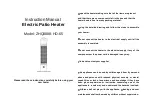
Installing the Water Heater 13
3.1 Choosing an Installation Location
When choosing an installation location, you must ensure that
the location provides adequate clearance for the water heater,
adequate venting and drainage options, and sufficient access to
gas, water, and electrical supplies. Carefully consider the following
factors when choosing an installation location:
About Water Quality
Proper maintenance of the water heater is required to ensure
that your water meets EPA quality standards. The following table
shows the maximum contaminant levels allowed, based on the
EPA National Secondary Drinking Water Regulations (40 CFR Part
143.3). If you suspect that your water is contaminated in any way,
discontinue use of the water heater and contact an authorized
technician or licensed professional.
Contaminant
Maximum Allowable Level
Total Hardness
200 mg/l (12 grains/gallon)
Aluminum
0.05 to 0.2 mg/l
Chloride
250 mg/l
Copper
1.0 mg/l
Iron
0.3 mg/l
Manganese
0.05 mg/l
pH
6.5-8.5
Sulfate
205 mg/l
Total Dissolved Solids (TDS)
500 mg/l
Zinc
205 mg/l
Access to utilities
Water – the installation location should be near where the
●
domestic water supply enters the building.
Gas – the installation location should be near where the gas
●
supply enters the building.
Electricity – the installation location should be near where the
●
electrical supply enters the building.
Adequate drainage
The water heater produces a significant amount of condensate
during operation. The water heater should be located near a
suitable drain and where damage from a possible leak will be
minimal. Installing the water heater in a location without a drain
will void the warranty and Navien will not be responsible for
water damages that occur as a result. For more information about
condensate drainage, refer to “3.5 Connecting the Condensate
Drain“ on page 25.
The water heater should be located in an area where leakage of the
unit or connections will not result in damage to the area adjacent
to the appliance or to lower floors of the structure. When such
locations cannot be avoided, it is recommended that a suitable
drain pan, adequately drained, be installed under the water heater.
The pan must not restrict combustion air flow.
Adequate venting and ventilation
Select a location that requires minimal venting. Consider venting
restrictions caused by windows, doors, air intakes, gas meters,
foliage, and other buildings. For more information about venting,
refer to “3.6 Venting the Water Heater“ on page 26.
To ensure adequate venting and ventilation, follow these
guidelines:
Maintain proper clearances from any openings in the building.
●
Install the water heater with a minimum clearance of 12 inches
●
(300mm) above an exterior grade or as required by local codes.
Maintain a minimum clearance of 4 feet (1.2 meters) from
●
heating and cooling vents.
Do not enclose the vent termination.
●
Install the exhaust vent in an area that is free from obstructions
●
and does not allow the exhaust to accumulate.
Do not install the water heater where moisture from the exhaust
●
may discolor or damage walls.
Do not install the water heater in bathrooms, bedrooms, or any
●
other occupied rooms that are normally kept closed or that are
not adequately ventilated.
Proximity to fixtures and appliances
Install the water heater near fixtures that deliver or use hot water,
such as bathroom, kitchen, and laundry room faucets. Select a
location that minimizes the water piping required between major
fixtures. If the distances are long or if the water heater requires
“instant“ hot water, we recommend running a recirculation line
back to the water heater from the furthest fixture. Insulate as
much of the hot water supply and recirculation lines as possible.
For more information about the water supply, refer to “3.4
Connecting the Water Supply“ on page 19.
3. Installing the Water Heater
Содержание NPE-180A
Страница 61: ...Appendixes 61 5 5 6 Fan Gas Assembly 1 8 13 14 15 6 2 4 5 10 10 10 3 11 7 9 12...
Страница 66: ...Memo...
Страница 67: ......














































